|
January got 2003 off to a mild start, with two record high temperatures being set on the 7th and 8th. Temperatures would fall off to the seasonable normals by mid month however, and continue that trend for the rest of the month. It was a rather dry for the most part, with under 1/10 of an inch of liquid equivalent precipitation through the first 27 days. January is usually the snowiest month of the year, and it was in 2003, but just barely. A total of 7 inches fell, with 5.3 inches of the total coming on 3 out of the last 4 days.
|
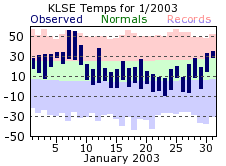 |
| |
|
February temperatures felt more like a typical January, and averaged nearly 5 degrees below normal. The coldest temperature of the year occurred on the morning of the 7th, when mercuries fell to 12 below. It was another dry month, with the bulk of the precipitation falling in the first half of the month. In addition, half the month’s snowfall fell on the 3rd (3.2 inches), while less than ½ inch fell after the 12th.
|
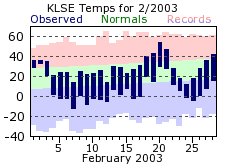 |
| |
|
March averaged a degree colder than normal, but experienced a wide range of temperatures. The start of the month was rather chilly, with lows falling below zero 3 times. Within a week of the last below zero reading of the 2002-03 winter however (-5 on the 10th), high temperatures reached the 70 degree mark (on the 16th). This 70 degree day was about 3 weeks earlier than the usual first occurrence of a 70 degree temperature for La Crosse, which is April 9th. March had more than double the amount of precipitation of both January and February combined, and finished ½ inch above normal. The bulk of this precipitation fell as rain, although the month still recorded 6 inches of snow.
|
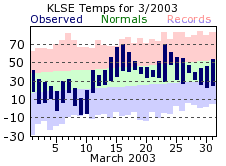 |
| |
|
April ran the gambit of temperatures, which is typical for the month. The month began with a 74 degree reading, but highs then failed to reach freezing on the 4th (31 degrees). By the 14th, some might have mistaken it for July, as temperatures shot up to 90 degrees, setting a new record for that day. April was another dry month, finishing nearly an inch below normal. In addition, most of the rain that fell came on the 16th and 19th, accounting for 2/3rds of the total. There was some significant snowfall during April though, with a spring storm dropping nearly 5 inches on the 7th.
|
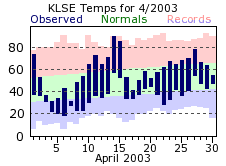 |
| |
|
May continued the cool trend of 2003, averaging almost 3 degrees below normal. Temperatures didn’t reach 80 until the last few days of the month, and only 9 days averaged above normal. May was the wettest month of the year, yet only finished around ½ inch above normal. The wettest stretch of the month was from the 4th through the 14th, when rain fell on everyday but the 12th and 13th. This string of days accounted for over 90% of the monthly total. May had its share of breezy days, which is common for this spring month. The two windiest days of the year, by average, occurred on the 11th and 30th. The 11th was the windier of the two, averaging 21.5 mph for the entire day.
|
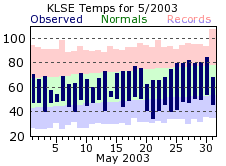 |
| |
|
|
June got the traditional summer months off to a cool start, with below normal temperatures for 11 out of the first 12 days. Seasonable temperatures returned for the later half of the month, but cracked 90 degrees only once. In a usual June, there are nearly 4 days of 90 degree or better heat. What would be a trend for 2003, June was another dry month. Although the month was 1 ½ inches below normal, the rain was spread out, with 9 days recording a 1/10 or more inches of rain.
|
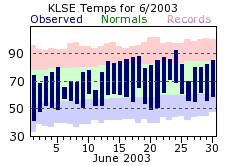 |
| |
|
July was near normal for temperatures, but felt a lot more like summer compared to June. High temperatures failed to climb to 80 degrees or better on only 5 days, while 4 days reached 90 or higher. The start of the month brought some relief to building drought conditions, with 8 straight days of measurable rain (the 3rd through the 10th). However, the 2.23 inches recorded over that time would be 89% of the monthly total. Only 0.28 inches would fall the rest of the month, with almost all of that falling on the 31st. This left a stretch of 20 straight days with only 0.01 inches of rainfall. The peak wind gust for the year occurred in July, with a 66 mph gust from the west on the 4th.
|
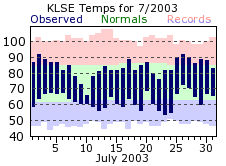 |
| |
|
August was the hottest month of 2003, easily outdistancing July, which is normally the hottest. There was one significant stretch of heat at mid month, with temperatures topping out at 90 degrees or greater from the 13th through the 20th. The hottest day of the year would occur a few days later though, with 99 degrees baking La Crosse on the 24th. Overall, there were 11 days of 90 degrees or greater, which is well above the normal of 4 such days for August. In fact, the month nearly reached the yearly normal for days with such temperatures, which is 18. The area was well into a drought by the time August started, and another month of very dry conditions did little to alleviate it. La Crosse recorded measurable rainfall on only 3 days in the month of August, with a stretch of 18 days without even a trace (the 7th through 24th).
|
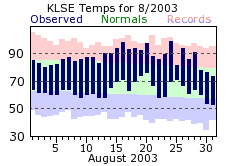 |
| |
|
| September was a tale of two halves, with the first part of the month continuing the summer warmth, then a quick transition to fall conditions for the last part. Three days of 90 degree or better heat effected the area on the 6th through the 8th, with some 80 degree readings still occurring through mid month. However, the last week of September saw high temperatures tumble into 50s, with lows nearing the freezing mark by month’s end. Another below normal month for rainfall continued the dire drought conditions. Nearly all of September’s total fell on two days (2.23 inches on the 12th and 18th), which left 22 of the 30 days with a trace of less of rainfall |
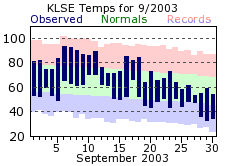 |
| |
|
October would be the 5th straight month with below normal precipitation, with a total deficit over that time of over 8 ½ inches. The first flurries of the new snowfall season would occur this month though, with a few flakes falling on the 28th. Temperatures were near normal, but fluctuated throughout the month. The first freezing temperatures of the new winter season occurred on the 1st, yet an 83 degree high temperature was recorded as late as the 20th. In a normal year, the latest 80 degree day usually occurs by the 2nd of October.
|
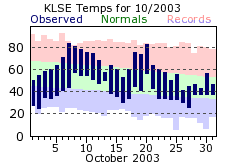 |
| |
|
|
November was rather uneventful on the whole, averaging near normal temperatures and precipitation. There were no significant cold or warm spells, nor extended periods of wet or dry weather. Temperatures did reach a monthly high of 65 on the 20th, dropping off to a high of 26 on the 24th, though. And one last gasp of fall came on the 30th, with highs reaching 58 degrees. The first measurable snowfall of the new winter season occurred on the 12th, with a tenth of an inch being recorded. This is close to the usual occurrence for this event, which is November 19th.
|
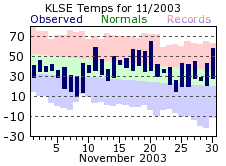 |
| |
|
| December was the 5th straight month which averaged near or above normal temperatures. Like November though, there were no significant swings in temperature. La Crosse did manage to dip below zero for lows on the 11th and 12th which was the first below zero readings of the new winter season. Although snowfall was a bit below normal, it was spread throughout the month, with a few tenths here and a few tenths there. Also, despite a warm up around the Christmas holiday, enough snow cover remained for a "white" Christmas. White Christmases usually occur in 7 out of every 10 years, with 2002 being the last non‑"white" Christmas. |
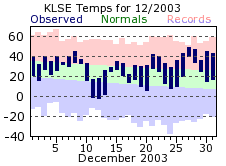 |
| |
|
| |
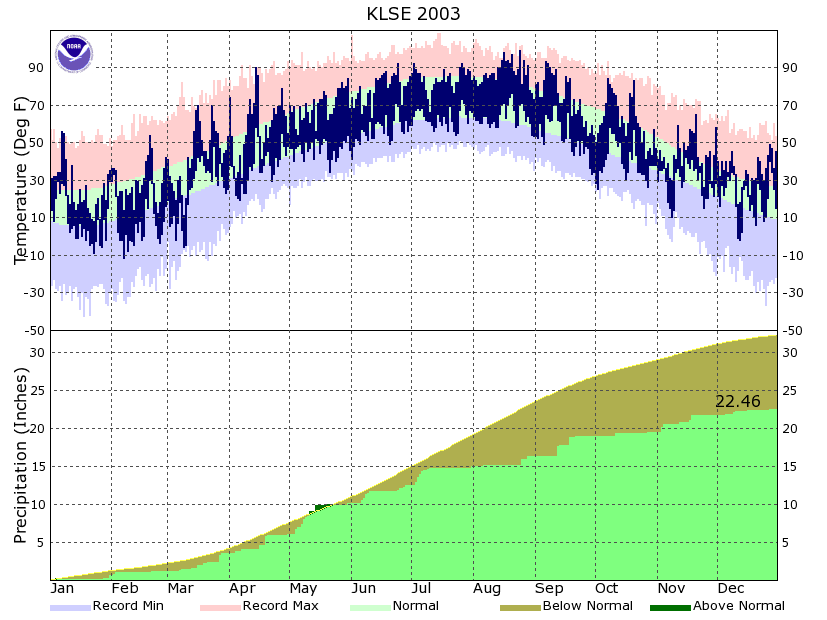 |
